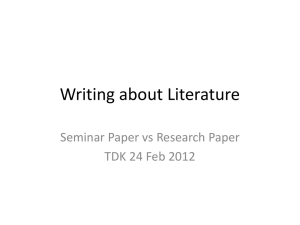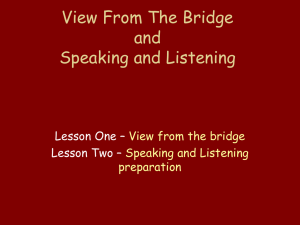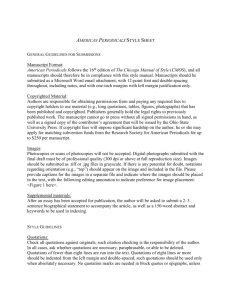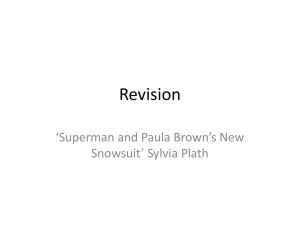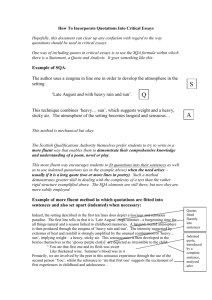ASOStyleGuidev1 - Alexander Studies Online
advertisement
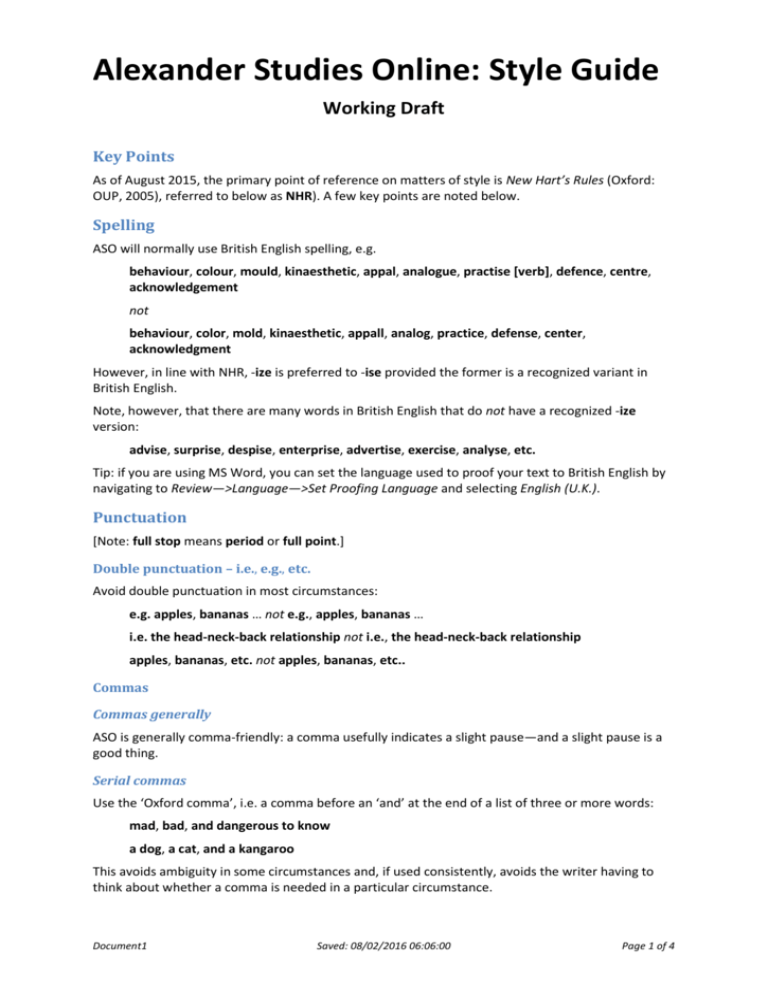
Alexander Studies Online: Style Guide Working Draft Key Points As of August 2015, the primary point of reference on matters of style is New Hart’s Rules (Oxford: OUP, 2005), referred to below as NHR). A few key points are noted below. Spelling ASO will normally use British English spelling, e.g. behaviour, colour, mould, kinaesthetic, appal, analogue, practise [verb], defence, centre, acknowledgement not behaviour, color, mold, kinaesthetic, appall, analog, practice, defense, center, acknowledgment However, in line with NHR, -ize is preferred to -ise provided the former is a recognized variant in British English. Note, however, that there are many words in British English that do not have a recognized -ize version: advise, surprise, despise, enterprise, advertise, exercise, analyse, etc. Tip: if you are using MS Word, you can set the language used to proof your text to British English by navigating to Review—>Language—>Set Proofing Language and selecting English (U.K.). Punctuation [Note: full stop means period or full point.] Double punctuation – i.e., e.g., etc. Avoid double punctuation in most circumstances: e.g. apples, bananas … not e.g., apples, bananas … i.e. the head-neck-back relationship not i.e., the head-neck-back relationship apples, bananas, etc. not apples, bananas, etc.. Commas Commas generally ASO is generally comma-friendly: a comma usefully indicates a slight pause—and a slight pause is a good thing. Serial commas Use the ‘Oxford comma’, i.e. a comma before an ‘and’ at the end of a list of three or more words: mad, bad, and dangerous to know a dog, a cat, and a kangaroo This avoids ambiguity in some circumstances and, if used consistently, avoids the writer having to think about whether a comma is needed in a particular circumstance. Document1 Saved: 08/02/2016 06:06:00 Page 1 of 4 Dashes Distinguish between hyphens, en rules and em rules: -, –, — Do not use a hyphen in place of an en or em rule. Use an em rule, without spaces, as the classic dash typically used to emphasise clauses or phrases in a sentence: There is nothing—absolutely nothing—more important than the ability to inhibit. Dashes used in this way should be in pairs. A single dash may introduce a similar element at the end of a sentence. Whilst extensive use of em rules in this way is commonly deprecated, from the ASO perspective it might be an aspect of an individual’s authorial style that we would prefer to respect: the distinctive impacts of commas, brackets, and dashes are subtle ones. Use an en rule for ranges, for to–from relationships, or otherwise to express close connection between two nouns: 1869–1955, Melbourne–Sydney railway, Carrington–MacDonald–Barlow differences Compare won by Ennis-Hill (hyphenated name) with Ennis–Hill experiment (an imaginary experiment conducted by two people called Ennis and Hill) but note that unfortunately these differences are not detectable in the online version of this Style Guide: refer to the PDF version attached to this page. Note: if you are using MS Word, en and em dashes can be inserted as follows: by navigating to InsertSymbolMore SymbolsSpecial Characters; if you are working with a full keyboard, by keying Ctrl+Alt+Num- for the em rule and Ctrl+Num- for the en rule; by typing two hyphens together for the em rule (depending on options set in MS Word); using this approach, be patient—it may take a while for the substitution to happen. Ellipsis Ellipses to indicated omitted text are spaced: The main argument … was hard to understand. You may use three stops as an ellipsis rather than inserting an ellipsis via the Insert Symbol route: the difference, if any, is not readily detectable. If you quote text that already contains an ellipsis, any editorial ellipsis should be in square brackets […] Quotations Embedded and blocked Embed quotations of twenty words or less in the containing sentence. Display longer quotations as blocks separated from the main text and formatted using the appropriate house style, defined more exactly via ASO MS Word templates. Use of quotation marks (inverted commas) Use single quotation marks around embedded quotations. If the quoted text includes a further quotation, this should be enclosed in double quotation marks. (This is the opposite of US practice.) Omit quotations marks around block quotations. Quotations that are inside block quotations should be punctuated normally for embedded quotations (see foregoing). Document1 Saved: 08/02/2016 06:06:00 Page 2 of 4 Interpolations Editorial interpolations or comments should be enclosed in square brackets: ‘He said that it [the manner of use of the primary control] would be a factor that would affect my general functioning’. Abbreviations, contractions etc Acronyms, initialisms Omit full stops and spaces from acronyms / initialisms: USA, BMJ not U.S.A., B.M.J. or U. S. A., B. M. J. Abbreviations (end of word omitted) Use a full stop at the end of abbreviations ed., assoc. not ed, assoc except technical quantities, e.g. oz, lb, g, mph, bhp, kmh Contractions Omit full stops from contractions (middle of word omitted): Dr, Mrs not Dr., Mrs. (eds) not (eds.) except St. for street, St for saint Indefinite article before abbreviations Use a or an depending on pronunciation, not whether the word begins with a consonant or vowel, thus: a BBC reporter, a UN mission and an IOU, an SOS signal, an MBA Citations, footnotes, endnotes To maintain the flow of prose, references are preferably made via numbered endnotes rather than citations in the text. Exceptions may apply in certain cases, e.g. where a piece involves detailed comparisons between texts from different sources and it is more useful to see the exact references immediately. In such cases, it may be appropriate to use specially abbreviated citations (e.g. MSI, UoS: further guidance forthcoming). Whilst footnotes can be valuable, their use is deprecated because of the difficulty in embedding footnotes where works are formatted to be read online. (This guidance may be revisited if new technology emerges). Endnotes should be numbered sequentially using MS Word or similar built-in endnote functionality: this significantly reduces the editorial resource needed to publish your material. Never attempt to use the same endnote number twice: this throws the whole system out of gear. Document1 Saved: 08/02/2016 06:06:00 Page 3 of 4 Using endnotes means there is rarely a need for a separate list of references (i.e. a bibliography). However, each case should be taken on its merits. For example, numerous references to the same works might indicate the need for a reference section. Guidance on the format for references is available separately. Document1 Saved: 08/02/2016 06:06:00 Page 4 of 4
